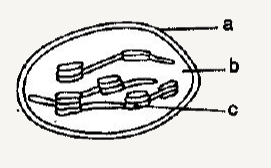Biosynthetic phase of photosynthesis
Involves use of ATP and NADPH to form food
Continues for long time if light is unavailable
Occurs in thylakoids only
Depends on light directly
The correct Answer is:A
Step-by-Step Solution:
1. Understanding the Biosynthetic Phase: The biosynthetic phase of photosynthesis, also known as the Calvin Cycle or dark reactions, is the process where carbon dioxide is converted into glucose using the energy stored in ATP and NADPH produced during the light-dependent reactions.
Hint: Remember that the biosynthetic phase is often referred to as the "dark phase" because it does not require light directly.
2. Location of the Reactions: These reactions occur in the stroma of the chloroplasts, not in the thylakoids. The stroma is the fluid-filled space surrounding the thylakoids where the Calvin Cycle takes place.
Hint: Think about where the light reactions occur (thylakoids) versus where the dark reactions occur (stroma).
3. Dependence on Light: While the biosynthetic phase does not require light directly, it depends on the products (ATP and NADPH) generated from the light-dependent reactions. Therefore, it can occur in the absence of light but will eventually stop if light is not available for an extended period.
Hint: Consider how the products from the light reactions are essential for the biosynthetic phase to function.
4. Duration of Activity: The biosynthetic phase does not continue indefinitely in the absence of light. It can operate for a limited time using stored ATP and NADPH, but it will eventually cease when these products are depleted.
Hint: Remember that while the biosynthetic phase can function without light for a short time, it is not sustainable in the long term without the light reactions.
5. Final Conclusion: Based on the analysis of the options provided:
- Option A: Involves the use of ATP and NADPH to form food (correct).
- Option B: Continues for a long time if light is unavailable (incorrect).
- Option C: Occurs in thylakoids only (incorrect).
- Option D: Depends on light directly (incorrect).
The correct answer is Option A.
Summary of the Correct Answer:
The biosynthetic phase of photosynthesis involves the use of ATP and NADPH to form glucose, and it occurs in the stroma of chloroplasts, not in the presence of light directly.
- Option A: Involves the use of ATP and NADPH to form food (correct).
- Option B: Continues for a long time if light is unavailable (incorrect).
- Option C: Occurs in thylakoids only (incorrect).
- Option D: Depends on light directly (incorrect).
The biosynthetic phase of photosynthesis involves the use of ATP and NADPH to form glucose, and it occurs in the stroma of chloroplasts, not in the presence of light directly.
Topper's Solved these Questions
Similar Questions
Knowledge Check
Which of the following is produced during the light phase of photosynthesis?
AATPBNADPH_(2)CBoth ATP and NADPH2DCarbohydrates
Rate of photosynthesis is
View SolutionList the events taking place in the photochemical phase of photosynthesis
View SolutionThe photochemical phase of photosynthesis includes (a) Water splitting (b) Light absorption (c) Oxygen release (d) Synthesis of NADPH (e) Synthesis of starch
View SolutionName the following :
The process of conversion of ADP to ATP during the first phase of photosynthesis.
View SolutionBiochemical phase in photosynthesis was discovered for the first time by using C14
View SolutionDefine photosynthesis.
View SolutionIn the diagram drawn alongside
(i) Label the parts a, b and c.
(ii) In which part does the light reaction occur?
(iii) Name the part which the dark phase of photosynthesis occur in.
View Solution
